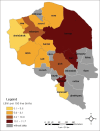Prevalence and Risk Factors of Low Birth Weight in the Southeast of Iran
- PMID: 28348722
- PMCID: PMC5353762
- DOI: 10.4103/ijpvm.IJPVM_112_16
Prevalence and Risk Factors of Low Birth Weight in the Southeast of Iran
Abstract
Background: The purpose of this study was to determine the prevalence and related factors of low birth weight (LBW) in the Southeast of Iran.
Methods: This cross-sectional study was carried out in Kerman province. Data were collected from Iranian Maternal and Neonatal Network at public and private hospitals. All live births from March 2014 to March 2015 considered as the source population. The risk factors including maternal age, gravida, parity, abortion, pregnancy risk factors, maternal nationality, maternal education, maternity insurance, place of living, consanguinity, neonate sex, preterm labor, place of birth, delivery manager, and delivery type were compared between LBW and normal birth weight groups.
Results: The prevalence of LBW was 9.4% in the present study. Preterm labor (odds ratio [OR]: 22.06; P < 0.001), neonate female sex (OR: 1.41; P < 0.001), low parity (OR: 0.85; P < 0.001), pregnancy age <18 years (OR: 1.26; P = 0.012), pregnancy age >35 years (OR: 1.21; P = 0.001), delivery by cesarean section (OR: 1.17; P = 0.002), pregnancy risk factors (OR: 1.67; P < 0.001), maternal illiteracy (OR: 1.91; P < 0.001), living in the rural area (OR: 1.19; P < 0.001), consanguineous (OR: 1.08; P = 0.025), and delivery by obstetrician (OR: 1.12; P = 0.029) were identified as significant factors associated with LBW in this study.
Conclusions: Prevention of preterm labor, consanguineous marriage, pregnancy age <18 and >35 years old, and maternal medical risk factors are some critical interventions to reduce its burden. Increasing the access to high-quality health-care services in rural and deprived areas is another effective strategy for the prevention of LBW.
Keywords: Low birth weight; prevalence; risk factor.
Conflict of interest statement
There are no conflicts of interest.
Figures
Similar articles
-
Risk factors for preterm and term low birthweight in Ahmedabad, India.Int J Epidemiol. 1992 Apr;21(2):263-72. doi: 10.1093/ije/21.2.263. Int J Epidemiol. 1992. PMID: 1428479
-
[Risk factors for low birth weight and intrauterine growth retardation in Santiago, Chile].Rev Med Chil. 1993 Oct;121(10):1210-9. Rev Med Chil. 1993. PMID: 8191127 Spanish.
-
Incidence of low birth weight in mazandaran province, northern iran.Oman Med J. 2013 Jan;28(1):39-41. doi: 10.5001/omj.2013.09. Oman Med J. 2013. PMID: 23386944 Free PMC article.
-
Low birthweight, preterm births and intrauterine growth retardation in relation to maternal smoking.Paediatr Perinat Epidemiol. 1997 Apr;11(2):140-51. doi: 10.1046/j.1365-3016.1997.d01-17.x. Paediatr Perinat Epidemiol. 1997. PMID: 9131707
-
Prevalence and determinants of caesarean section in Jamaica.J Biosoc Sci. 1992 Oct;24(4):515-25. doi: 10.1017/s0021932000020071. J Biosoc Sci. 1992. PMID: 1429779
Cited by
-
Predictors of low birthweight and comparisons of newborn birthweights among different groups of maternal factors at Rev. John Chilembwe Hospital in Phalombe district, Malawi: A retrospective record review.PLoS One. 2024 Aug 29;19(8):e0291585. doi: 10.1371/journal.pone.0291585. eCollection 2024. PLoS One. 2024. PMID: 39208326 Free PMC article.
-
Caesarean Section Delivery Is Associated with Childhood Overweight and Obesity, Low Childbirth Weight and Postnatal Complications: A Cross-Sectional Study.Medicina (Kaunas). 2023 Mar 27;59(4):664. doi: 10.3390/medicina59040664. Medicina (Kaunas). 2023. PMID: 37109623 Free PMC article.
-
Predictors of Low Birth Weight at Lumbini Provincial Hospital, Nepal: A Hospital-Based Unmatched Case Control Study.Adv Prev Med. 2020 Mar 26;2020:8459694. doi: 10.1155/2020/8459694. eCollection 2020. Adv Prev Med. 2020. PMID: 32274216 Free PMC article.
-
Patterns of Socioeconomic Inequities in SDGs Relating to Children's Well-Being in Thailand and Policy Implications.Int J Environ Res Public Health. 2022 Oct 20;19(20):13626. doi: 10.3390/ijerph192013626. Int J Environ Res Public Health. 2022. PMID: 36294206 Free PMC article.
-
Low birth weight in Iran: Implications from a systematic review of the literature and meta-analysis in the period 1999-2017.Med J Islam Repub Iran. 2018 Feb 13;32:13. doi: 10.14196/mjiri.32.13. eCollection 2018. Med J Islam Repub Iran. 2018. PMID: 30159264 Free PMC article.
References
-
- Ramakrishnan U. Nutrition and low birth weight: From research to practice. Am J Clin Nutr. 2004;79:17–21. - PubMed
-
- Wardlaw TM. Low Birthweight: Country, Regional and Global Estimates. UNICEF and WHO Publications. 2004
-
- Ohlsson A, Shah P. Determinants and Prevention of Low Birth Weight: A Synopsis of the Evidence. Alberta, Canada: Institute of Health Economics; 2008.
-
- Chiarotti F, Castignani AM, Puopolo M, Menniti-Ippolito F, Minniti De Simeonibus E, Di Paolo A. Effects of socio-environmental factors on neurocognitive performance in premature or low-birth weight preschoolers. Ann Ist Super Sanita. 2001;37:553–9. - PubMed
LinkOut - more resources
Full Text Sources
Other Literature Sources


